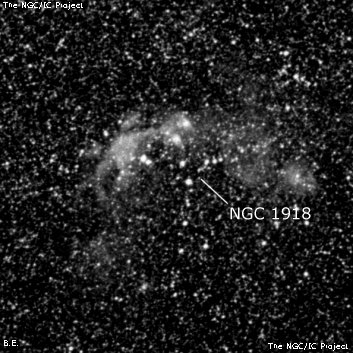
These stars are immersed in a diffuse nebulous glow that responds well to a UHC filter. The brightest section is a patch just east of the double star (LMC-N120C), but nebulosity extends throughout the cluster as an elongated glow of ~5' length. On images the nebulosity appears more like an arc or rim with some filamentary structure.
LMC-N127A, located 12' E, was observed in the 30" on 10/18/17. At 264x this emission nebula was bright, compact, roundish, 40" diameter. A star was visible at the center. Very good response to the NPB (narrow-band) filter and displayed a slightly brighter central region and thin fainter outer halo. Forms a "pair" with open cluster S-L 418 2' NE.
James Dunlop discovered NGC 1918 = D 88 on 27 Sep 1826 and described a "small faint nebula, 25" or 30" diameter, with two small stars near the south side of it." His position is about 13' too far SE, but the double star is within the nebula.
John Herschel independently discovered this nebula (SNR) between Nov 1836 and Mar 1837 with a 5-inch refractor and recorded it as #369 in his catalogue of "Stars, Nebulae and Clusters in the Nubecula Major." Corwin notes Herschel's position falls between two bright knots near the supernova remnant.
600/800mm - 24" (4/5/08 - Magellan Observatory, Australia): this is a combination LMC cluster and nebula (contains an embedded SNR B0519-69.6) in the rich LMC central bar. At 200x a striking double star (TDS 3145 = 11.6/11.8 at 9") sits within the glow with a third star in a line. The brighter SW component is HD 35517 = Brey 22, a Wolf-Rayet binary. An additional 20 stars are resolved in the cluster (stellar association LH 42).
Notes by Steve Gottlieb